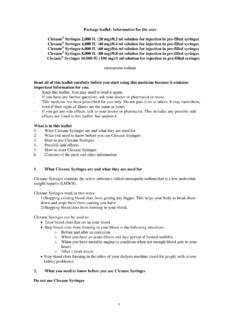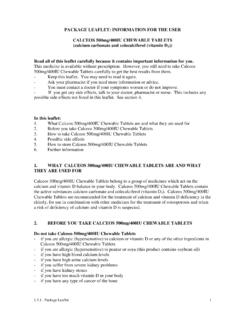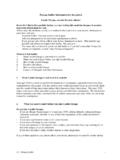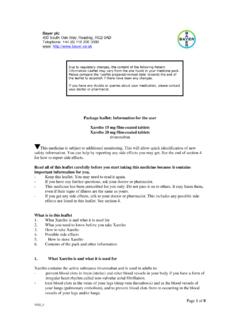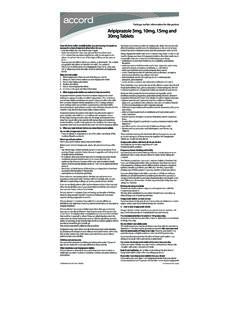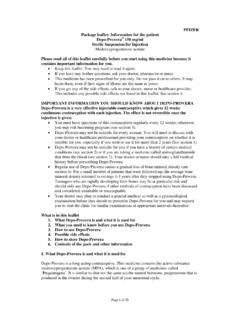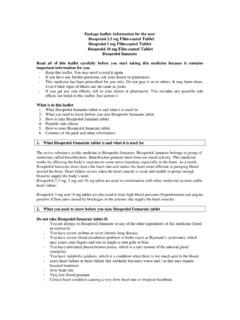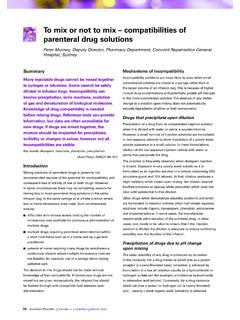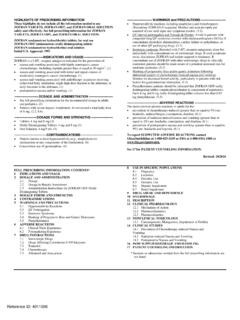Transcription of Tramadol 50 mg capsules, hard
1 Read all of this leaflet carefully before you start taking this medicine because it contains important information for Keep this leaflet. You may need to read it If you have any further questions, ask your doctor or This medicine has been prescribed for you only. Do not pass it on to others. It may harm them, even if their signs of illness are the same as If you get any side effects, talk to your doctor or pharmacist. This includes any possible side effects not listed in this leaflet. See section is in this leaflet1. What Tramadol is and what it is used for2. What you need to know before you take Tramadol 3. How to take Tramadol 4. Possible side effects5. How to store Tramadol 6. Contents of the pack and other information1. What Tramadol is and what it is used forTramadol hydrochloride - the active substance in Tramadol - is a painkiller belonging to the class of opioids that acts on the central nervous system.
2 It relieves pain by acting on specific nerve cells of the spinal cord and is used for the treatment of moderate to severe must talk to a doctor if you do not feel better or if you feel worse after number of What you need to know before you take Tramadol Do not take Tramadol - if you are allergic to active substance or any of the other ingredients of this medicine (listed in section 6).- if you are under the influence of alcohol or sedative drugs including sleeping pills, other pain-killers or tranquiliser medicines- if you are taking, or have taken in the last two weeks, certain medicines called monoamine oxidase inhibitors or MAOIs (used to treat depression, and the antibiotic linezolid). The combination could result in a serious, potentially life threatening interaction- if you have epilepsy that is not controlled with your current medicine;- as a substitute in drug and precautionsTalk to your doctor or pharmacist before taking Tramadol - if you suffer from epilepsy or seizures (fits) or have had them in the past because Tramadol could increase the risk of you having further fits- if you have liver or kidney with all painkillers of this type (opioid analgesics), Tramadol should be used with caution, and only under medical supervision in seriously ill patients including those with breathing difficulties, excessively low blood pressure (shock), decreased consciousness, serious head injury or brain diseases that may cause elevated pressure in the with all medicines of this type, Tramadol may lead to psychological and physical dependence or addiction in some people, especially with long term use.
3 The dose needed to achieve the desired effect may increase with time. Tramadol should be used with caution, and only for short periods, in patients who are addicted to other opioid is transformed in the liver by an enzyme. Some people have a variation of this enzyme and this can affect people in different ways. In some people, they may not get enough pain relief but other people are more likely to get serious side effects. If you notice any of the following side effects, you must stop taking this medicine and seek immediate medical advice: slow or shallow breathing, confusion, sleepiness, small pupils, feeling or being sick, constipation, lack of and adolescents Use in children with breathing problems Tramadol is not recommended in children with breathing problems, since the symptoms of Tramadol toxicity may be worse in these children. Other medicines and Tramadol Tell your doctor or pharmacist if you are taking, have recently taken or might take any other not take Tramadol at the same time as medicines called monoamine oxidase inhibitors or MAOIs (which are used to treat depression), or if you have taken MAOIs in the past 2 pain-relieving effect of Tramadol may be weakened and/or shortened if you also take medicines containing:- carbamazepine (used to treat epilepsy)- pentazocine, nalbuphine or buprenorphine (pain killers)- ondansetron (used to stop you feeling sick).
4 The risk of side effects increases if you take Tramadol at the same time as:- if you are taking medicines which may cause convulsions (fits), such as certain antidepressants or antipsychotics. The risk having a fit may increase if you take Tramadol at the same time. Your doctor will tell you whether Tramadol is suitable for you. - if you are taking certain antidepressants. Tramadol may interact with these medicines and you may experience symptoms such as involuntary, rhythmic contractions of muscles, including the muscles that control movement of the eye, agitation, excessive sweating, tremor, exaggeration of reflexes, increased muscle tension, body temperature above 38 C. - sedative medicines such as tranquillizers, sleeping pills, antidepressants and other pain relievers (morphine, codeine); you may feel excessively drowsy or feel that you might faint- medicines that prevent blood clotting, such as warfarin; the dose of these medicines may need to be reduced, otherwise there could be an increased risk of potentially serious use of Tramadol and sedative medicines such as benzodiazepines or related drugs increases the risk of drowsiness, difficulties in breathing (respiratory depression), coma and may be life-threatening.
5 Because of this, concomitant use should only be considered when other treatment options are not if your doctor does prescribe Tramadol together with sedative medicines the dose and duration of concomitant treatment should be limited by your tell your doctor about all sedative medicines you are taking, and follow your doctor s dose recommendation closely. It could be helpful to inform friends or relatives to be aware of the signs and symptoms stated above. Contact your doctor when experiencing such with food and drink and alcoholYou should not drink alcohol during treament with Tramadol , as its effect may be and breast-feedingIf you are pregnant or breast-feeding, think you may be pregnant or are planning to have a baby, ask your doctor or pharmacist for advice before taking this is very little information regarding the safety of Tramadol during pregnancy. Tramadol should therefore not be used during pregnancy.
6 If you become pregnant you should inform your doctor as soon as is excreted into breast milk. For this reason, you should not take Tramadol more than once during breast-feeding, or alternatively, if you take Tramadol more than once, you should stop and using machinesTramadol may cause side effects such as sleepiness and dizziness. If this happens, do not drive or operate contains Sodium:This medicine contains less than 1 mmol sodium (23 mg) per capsule, that is to say essentially sodium-free .3. How to take TramadolAlways take use this medicine exactly as your doctor or pharmacist has told you. Check with your doctor or pharmacist if you are not capsules should be swallowed whole with a glass of capsules can be taken with or without food and should not be usual doses are given below. Your doctor may gradually increase or decrease your dose depending on how you respond to the dosage should be adjusted to the intensity of your pain and your individual pain sensitivity.
7 In general the lowest pain-relieving dose should be leaflet: Information for the userTramadol 50 mg capsules, hardTramadol hydrochlorideP1518706 BlackA/s: 140 x 400 mmDate & TimeComponentItem CodeReason Of IssueVersion / CountryReviewed / Approved bySign / DateProduct NameTramadol 50 mgLeafletP1518706 Milpharm & AMDimensionsPharmacodeTeam LeaderInitiatorAdditional Information :Artist:No. of Colours : 01140 x 400 mmArjunArief18706 Packaging DevelopmentSupersede Item Code: P1517928 Adults and adolescents aged 12 and overThe usual dose is 50 mg or 100 mg (1 or 2 capsules) every 4-6 hours, according to severity of pain. You should normally not take more than 400 mg (8 capsules) a below 12 years of ageTramadol is not recommended for use in children below age patientsIn elderly patients (above 75 years) the excretion of Tramadol may be delayed. If this applies to you, your doctor may recommend prolonging the dosage interval.
8 Severe liver or kidney disease (insufficiency)/ dialysis patientsPatients with severe liver and/or kidney insufficiency should not take Tramadol . If in your case the insufficiency is mild or moderate, your doctor may recommend prolonging the dosage you take more Tramadol than you shouldIf you have taken more capsules than you have been told to take, contact your doctor immediately or go to your nearest hospital casualty department. A number of symptoms may occur, which might include: vomiting (being sick), a fall in blood pressure, a fast heartbeat, collapse, fainting or even coma, epileptic fits and difficulties in you forget to take Tramadol If you forget to take Tramadol take it as soon as you remember and then carry on as before. Do not take a double dose to make up for a forgotten you stop taking Tramadol If you stop taking Tramadol , your pain may should not suddenly stop taking this medicine unless your doctor tells you to.
9 If you want to stop taking your medicine, discuss this with your doctor first, particularly if you have been taking it for a long time. Your doctor will advise you when and how to stop, which may be by lowering the dose gradually to reduce the chance of developing unnecessary side effects (withdrawal symptoms).If you would like to stop treatment because you have unpleasant side effects, please talk to your doctor. If you have been taking this medicine for a very long time, you may get the following side effects if you suddenly stop treatment: restlessness, anxiety, nervousness, shaking or an upset stomach. If you get any of these effects after stopping treatment with Tramadol please talk to your you have any further questions on the use of this medicine, ask your doctor or Possible side effectsLike all medicines, this medicine can cause side effects, although not everybody gets can occasionally cause allergic reactions although serious allergic reactions (including anaphylaxis and angioedema) are rare.
10 Contact a doctor or emergency unit immediately if you experience any sudden wheeziness, difficulty in breathing, swelling of the eyelids, face or lips, rash or itching (especially affecting your whole body). The same applies in case of seizures ( fits ).The frequency of side effects is classified as follows:Common: affects 1 to 10 users in 100 Uncommon: affects 1 to 10 users in 1,000 Rare: affects 1 to 10 users in 10,000 Very rare: affects less than 1 user in 10,000 Not known: frequency cannot be estimated from the available dataThe following side effects may occur:Very common: nausea; : headache, sleepiness; vomiting (being sick), constipation, dry mouth; : Irregular, rapid beating or pulsation of the heart, increased heartbeat, low blood pressure (especially when standing upright), this may lead to collapse. Diarrhoea, retching, gastrointestinal irritation (a feeling of pressure in the stomach, bloating); skin disorders ( itchiness, rash, sudden onset of skin redness).
